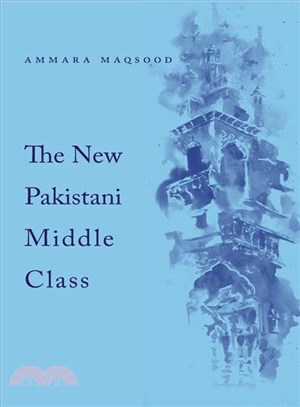The new Pakistani middle class /
正題名/作者 : The new Pakistani middle class // Ammara Maqsood.
作者 : Maqsood, Ammara,
出版者 : Cambridge, Massachusetts :Harvard University Press,c2017.
面頁冊數 : 194 p. :ill. ;25 cm.
標題 : Middle class - Pakistan -
標題 : Pakistan - Civilization -
ISBN : 9780674280038 (hbk.)
LEADER 02365cam 2200193 a 450
001 272880
005 20181010143049.0
008 170331s2017 maua b 001 0 eng
010 $a2017013546
020 $a9780674280038 (hbk.)
035 $a00321141
050 00$aHT690.P18$bM37 2017
082 00$a305.5/5095491/43$223
090 $a305.55/M322///UM061465
100 1 $aMaqsood, Ammara,$d1983-$3486657
245 14$aThe new Pakistani middle class /$cAmmara Maqsood.
260 $aCambridge, Massachusetts :$bHarvard University Press,$cc2017.
300 $a194 p. :$bill. ;$c25 cm.
504 $aIncludes bibliographical references (p. [169]-182) and index.
505 0 $aRemembering a modern Pakistan -- Moral rhetoric, modernity, and class -- Piety and new middle-class life -- Islam and consumption.
520 $aPakistan's presence in the outside world is dominated by images of religious extremism and violence. These images--and the narratives that interpret them--inform events in the international realm, but they also twist back around to shape local class politics. In The New Pakistani Middle Class, Ammara Maqsood focuses on life in contemporary Lahore, where she unravels these narratives to show how central they are for understanding competition and the quest for identity among middle-class groups. Lahore's traditional middle class has asserted its position in the socioeconomic hierarchy by wielding significant social capital and dominating the politics and economics of urban life. For this traditional middle class, a Muslim identity is about being modern, global, and on the same footing as the West. Recently, however, a more visibly religious, upwardly mobile social group has struggled to distinguish itself against this backdrop of conventional middle-class modernity, by embracing Islamic culture and values. The religious sensibilities of this new middle-class group are often portrayed as Saudi-inspired and Wahhabi. Through a focus on religious study gatherings and also on consumption in middle-class circles--ranging from the choice of religious music and home decor to debit cards and the cut of a woman's burkha--The New Pakistani Middle Class untangles current trends in piety that both aspire toward, and contest, prevailing ideas of modernity. Maqsood probes how the politics of modernity meets the practices of piety in the struggle among different middle-class groups for social recognition and legitimacy. --$cProvided by publisher.
650 0$aMiddle class$zPakistan$zLahore.$3486660
650 0$aIslamic renewal$zPakistan$zLahore.$3486661
651 0$aPakistan$xCivilization$xArab influences.$3486659
The new Pakistani middle class /Ammara Maqsood. - Cambridge, Massachusetts :Harvard University Press,c2017. - 194 p. :ill. ;25 cm.
Includes bibliographical references (p. [169]-182) and index.
Remembering a modern Pakistan -- Moral rhetoric, modernity, and class -- Piety and new middle-class life -- Islam and consumption.
Pakistan's presence in the outside world is dominated by images of religious extremism and violence. These images--and the narratives that interpret them--inform events in the international realm, but they also twist back around to shape local class politics. In The New Pakistani Middle Class, Ammara Maqsood focuses on life in contemporary Lahore, where she unravels these narratives to show how central they are for understanding competition and the quest for identity among middle-class groups. Lahore's traditional middle class has asserted its position in the socioeconomic hierarchy by wielding significant social capital and dominating the politics and economics of urban life. For this traditional middle class, a Muslim identity is about being modern, global, and on the same footing as the West. Recently, however, a more visibly religious, upwardly mobile social group has struggled to distinguish itself against this backdrop of conventional middle-class modernity, by embracing Islamic culture and values. The religious sensibilities of this new middle-class group are often portrayed as Saudi-inspired and Wahhabi. Through a focus on religious study gatherings and also on consumption in middle-class circles--ranging from the choice of religious music and home decor to debit cards and the cut of a woman's burkha--The New Pakistani Middle Class untangles current trends in piety that both aspire toward, and contest, prevailing ideas of modernity. Maqsood probes how the politics of modernity meets the practices of piety in the struggle among different middle-class groups for social recognition and legitimacy. --
ISBN: 9780674280038 (hbk.)
LCCN: 2017013546Subjects--Topical Terms:
486660
Middle class
--PakistanSubjects--Geographical Terms:
486659
Pakistan
--Civilization
LC Class. No.: HT690.P18 / M37 2017
Dewey Class. No.: 305.5/5095491/43
- 館藏(1)
- 心得(0)
- 標籤
- 相同喜好的讀者(0)
- 相關資料(0)

